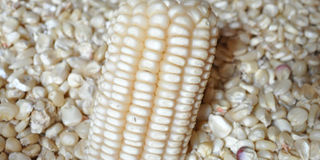Low maize prices, try value addition

Farmers had a bumper harvest early but ironically they are getting very little from the market. Photo by Rachel Mabala
With the high amount of rains we early received this year, everyone can say it has been a good season, because of the bumper harvests by farmers.
According to the East African Regional maize supply and market outlook report, 2017, Uganda is ranked one of the maize surplus-producing countries in East Africa.
However, these bumper maize harvests are currently suffocating the market with the prices of the products such as maize grains, maize bran and maize flour falling to record lows.
Victor Kawuki, a maize farmer and trader shares that prices have been affected by stable inflow of maize from the local communities and could still decline further as farmers are harvesting more maize.
“Since the prices were low the previous season, people hoarded maize expecting the prices to go up, which did not happen. This time around, a lot of people grew maize, so, the fresh maize found some old maize in the stores from the previous season pushing the supply higher,” says Kawuki.
Prices
A 100-kilogramme bag of maize is going for between Shs25,000 and Shs30,000 down from Shs60,000 last month and Shs150,000 last year. Whereas a kilogramme of maize was between Shs1,500 and Shs1,600 last season, today, the prices of maize are going lower.
According to Kawuki, as recent as last week a kilogramme of maize at farm gate was as low as Shs300 half the price of last season.
“The prices are falling further. A kilogramme of maize is at Shs200 in major producing districts such as Kiboga, Masindi, Kibale, Kasese and Kamwenge,” Kawuki adds.
“The consequences of low prices has started to hit us [farmers] and yet the amount we inject in in terms of inputs and cultivation up to the time of harvesting are high,” says Amooti Kanaginangi a farmer in Masindi.
Solutions
Cries have been made by farmers around the country about maize prices. We we explored available alternatives to salvage the situation.
Selling to Kenyans
Daudi Tamale has decided to sell his maize to Kenya. According to Tamale, at Shs400 per kilogrammes, Kenyans are offering a better price. “Many farmers are rushing to sell to the Kenyans because they give a higher price than to Ugandans,” says Tamale.
Other alternatives
A boiled and roasted maize cob on the streets of Kampala and suburbs goes for Shs700 which is more than double the price of a kilogramme of maize grains.
When we explored whether farmers can sell their maize as single cobs, Racheal Nankya, a maize farmer from Mpigi says this was possible when the maize was just getting ripe.
“Earlier in the season as the maize was just ripening, a truck was about Shs500,000. However, with more maize being harvested, it is now between Shs250,000 and Shs300,000.
But for someone with a means of transport and can drive their maize directly to the market, they are more at an advantage because they can sell a cob at a higher price,” says Nankya.
Value addition
Making animal feeds and maize flour, is the major value addition done to maize and there hasn’t been more macro value addition options to absorb all these tonnes of maize.
“The other value addition is beer making, but those markets do not utilise much of the maize grown in the whole country,” Kawuki says.
According to Winfred Barungi a trader of maize flour in Kikuubo, the price of flour is as well reducing.
A 50 kilogramme bag of maize flour (super) in the trading hub of Kikuubo is at Shs55,000 and a kilogramme at Shs1,100 compared to Shs2,500 per Kilogramme early last year.
The other option is to export the surplus to neighbouring countries such as Rwanda, Tanzania and South Sudan where the prices are a little higher, according to Tamale.
Storage
“If I may estimate, we have just harvested about 15 per cent of the total produce in the country, meaning, around 85 per cent is yet to be harvested. So, if you have a store where you can keep your maize up to around November – December, where we expect the prices to go higher, do that,” Kawuki advises.
Tips for proper storage
According to Dr Allan Ahimbisibwe, Spark Agro-initiatives, farmers lack proper storage facilities required to keep maize for more than 100 days.
“Our farmers do not have the capacity to hoard their produce because they lack storage such as silos, cribs and ginneries. We therefore need to adopt good storage facilities and management,” Dr Ahimbisibwe says.
Dr Ahimbisibwe advises farmers to properly dry the maize on tarpaulin or raised platforms to maintain quality.
The dry harvest should then be stored in hermetic bags to prevent attacks by weevils and if the grain is stored when it is still wet, it becomes discolored and the quality is reduced.
Wet grain is also attacked by mold which produces aflatoxins which make the grain unsafe for consumption by humans and livestock.
The stores should also be well ventilated for air inflow and outflow, covered on top with either iron sheets or grass as long as they don’t leak.
A sufficient supply of air at all times is needed since warm conditions are a good breeding ground for most insects and fungi.
The stores have to be kept clean, avoid placing the maize bags directly on the ground but on pellets or raised platforms to reduce the risks of pests.




